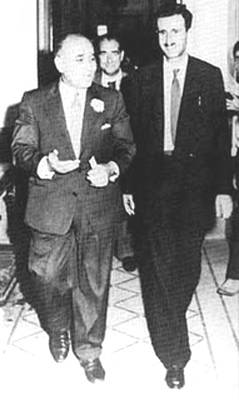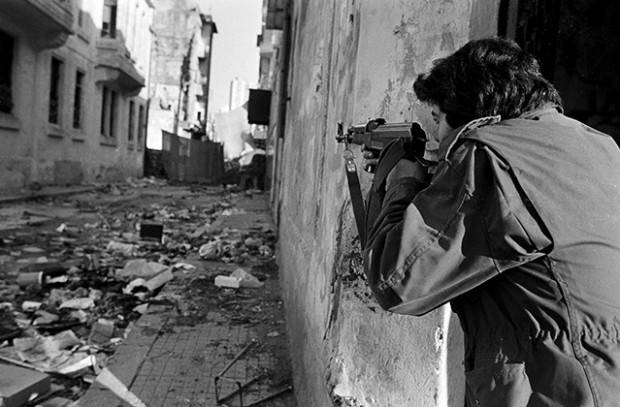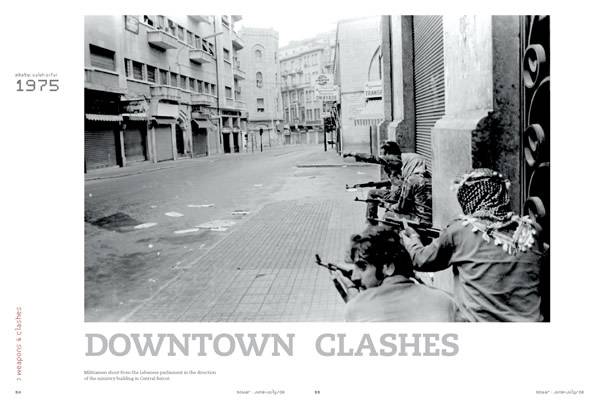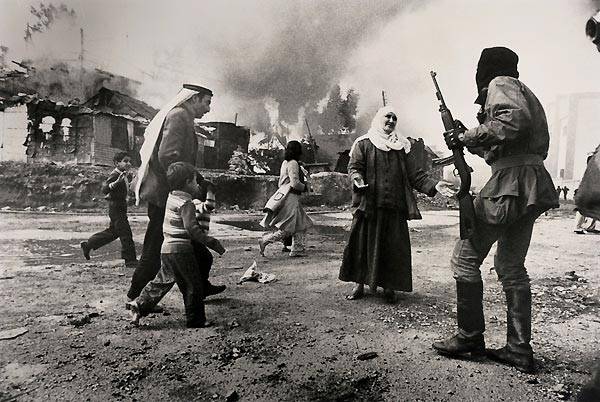How the Lebanese war began. H. 2
The confessional fragmentation of Lebanon became the basis of the civil war of 1975-1990, which put an end to the former well-being of "Middle Eastern Switzerland." And the trigger for this war were the Palestinian radicals who used Lebanon as a springboard for the struggle for Palestinian independence.
The Lebanese political elite finally split the issue regarding the Palestine Liberation Organization (PLO) and the finding of Palestinians in Lebanon in general. So Muslim leaders, including the prime minister, condemned the actions of the army against the PLO, calling on Muslim troops to disobey. At the same time, demonstrations in support of the army were held in the Christian areas of Lebanon. The Lebanese army began to rapidly disintegrate, the former military personnel joined the ranks of all kinds of military formations (militias), which were created by various confessional groups and parties. All major movements created their own armed formations.
One of the main political forces in Lebanon was the far-right Christian Phalangist party, Pierre Gemayel. Officially, the party was called the “Social Democratic Party (Kataib)”, but more often it was called “Phalanx”, since creating a party in the 1930s, Gemayel focused on the Spanish Phalangists of General Franco. It is worth noting that in the Middle East after World War II, pro-fascist sentiments were generally strong. Many Nazis, fascists and war criminals, after the defeat of the Third Reich and its allies, fled to the East, which became the springboard of the "black international" (a network of neo-Nazi movement dreaming of revenge). This was never advertised by Soviet propaganda, since Moscow supported the Arabs in their confrontation with Israel. Politics is a dark matter: the Soviet Union at this time was on the side of the Arab leaders, some of whom professed openly Nazi views, in their struggle against the Jewish state, created with the direct participation of the USSR, and even prominent anti-fascists. But Israel, which was originally created with a socialist bias, eventually followed the path of Jewish nationalism and the construction of "Greater Israel", becoming an ally of the United States. It was not in vain that the following chastushka was popular in 1970: It lies in the sun, warms the belly of a semi-fascist, half-star, Hero of the Soviet Union Abdel Gamal on all of Nasser. And the president of Egypt, Anvar Saddat, who followed Nasser in general, during the Second World War, secretly collaborated with agents of Nazi Germany and fascist Italy, with the goal of liberating the country from British rule.
Maronite Christians of Lebanon have traditionally maintained good relations with Israel. Thus, during the six-day war, the Christian militia surrounded the Jewish quarters of Beirut and did not allow Muslims to inflict reprisals on the peaceful Jewish population. The Phalang brigades actively opposed the PLO supporters, seeing in Palestinians a threat to the sovereignty of Lebanon, but on the other hand were in opposition to the current president, Suleiman Frangie, who was supported by the Marad brigades, which were oriented toward Syria. The total number of Christian militias (Phalanx, Tigers Akhrar, Guardians of Cedars, El-Tanzim, Marad Brigades, etc.) and the small Armenian units that joined them amounted to about 15 thousand fighters. However, these forces were not homogeneous. For example, the military units “Guardians of the Cedars” professed the secular ideology of Lebanese nationalism, their main goal being the struggle against foreigners-Palestinians. In the ranks of the "Guardians" it was possible to meet Sunnis, and even Shiites, who support this ideology, although the foundation was made up of Christians.
In 1976, the “Lebanese Front” was formed - a political coalition of Christian parties during the Lebanese civil war. The military wing of the “Lebanese Front” was the “Lebanese forces”, the founder of which was Bashir Gemayel. The Christian militia controlled East Beirut and the territories in Gorny and Northen Lebanon, totaling about 30-35% of the country's territory. These territories were mainly inhabited by Maronite, Greek Catholic, and Orthodox Christians, although there were also large communities of Shiite Muslims and Sunnis. For the most part, the Armenian community of Lebanon remained neutral, although some Armenians fought as part of the Lebanese Forces. Lebanese Assyrians joined the Lebanese Forces by organizing a battalion of volunteers 4. Initially, the military advantage aside was on the side of the Christian militia, better armed and prepared, although it had less manpower.
On the other hand, the Muslim community of Lebanon, spoke in support of the PLO. Their close ally was the National-Patriotic Forces of Lebanon (NPS), led by Kamal Jumblat. Kamal Jumblatt is a well-known Lebanese writer and philosopher, one of the most authoritative secular leaders of the Druze community of Lebanon, the leader of the Lebanese left, the leader of the Progressive Socialist Party and a great friend of the Soviet Union, the winner of the Lenin Prize for Strengthening Peace among Nations (1972). As Minister of the Interior, he legalized the Lebanese Communist Party and the Syrian Socialist Nationalist Party. Behind Jumblat there were paramilitary forces of Druze (about 5 thousand people), the Communist Party of Lebanon (5 thousand people), as well as smaller units. Jumblatt not only shared the goals of the PLO, but also offered to use it as a core, around which it would be possible to rally various Muslim communities in order to reform the political system of Lebanon and restrict the country's Christian community to rights. In total, the PLO and its supporters had more than 45 thousands of fighters, that is, left Muslims had a significant numerical advantage over the Lebanese army and the Christian militia.
In addition, in the militia of each of the opposing camps there were volunteers and mercenaries from different countries of the world. The sources of funding for the police were the support of local parties and clans and direct financial assistance from foreign countries, as well as extortion, robbery, control over the flow of drugs and smuggling weapons in controlled territories. In general, all this, but on a larger scale, we see in modern Iraq, Syria and Libya (the so-called "Middle Eastern Front").
Thus, Lebanon split along political and confessional lines - right-wing Christians against left-wing Muslims, including Palestinians. In turn, right-wing Christians were supported by Israel and the United States, and left-wing Muslims by Arab countries and the USSR.

Head of the "Lebanese Front" Bashir Pierre Gemayel

Leader of the National Patriotic Forces of Lebanon Kamal Jumblatt (right)
The first stage of the civil war
Immediately after the president created the military cabinet, the National-Patriotic Forces (NPS) of Jumblatt together with the PLO and most Muslim politicians began to insist on replacing it with the so-called “government of salvation” led by Rashid Karame. As a result, armed clashes between Christian and Muslim formations began. President Frangie was forced to agree to the requirements of the NPC.
However, the “National Dialogue Committee”, created in September of 1975 to resolve conflicts between Christians and Muslims, is mired in controversies. Christian right-wing leaders demanded that the country retain sovereignty over its entire territory. And the NPS, led by Jumblat, insisted on introducing changes to the existing political system, restoring a new balance between Christians and Muslims, without taking into account the presence of the PLO in Lebanon. As a result, a compromise could not be found. Openly hostile to the Palestinians, the position of "Phalanx" led to open war.
Soon private clashes acquired the character of a universal and very fierce (typical of ethno-religious conflicts) war. The conflict acquired the features of mutual genocide. We see a similar situation during the current war in the Middle East. The fighters of the “Caliphate” and “moderate” gangs in Syria and Iraq exterminate other confessional and ethnic minorities - Christians, Druze, Kurds, Alawites, etc. Men are completely destroyed, girls and children are sold into slavery. In Iraq, the Shiite pro-government militia brutally, following the example of the Nazi Sonderkommando, exterminates the Sunnis (in particular, during the storming of Mosul). Mutual genocide of the peoples of the Middle East, and taking into account the total destruction of the infrastructure of the region, losses multiply (hunger, illness, lack of medical care, the impossibility of normal hygiene, etc.) completely fit into the plans of the Western masters, who plunge Eurasia into turmoil and chaos, solving the problem of reduce the "excess" human population. This is one of the most important tasks of the current world war.


Street fighting in Beirut
By September, the Palestinians, with the support of artillery, stormed the Christian city of Zakhle. The pro-Syrian Palestinian troops of Al-Sahik ("Thunderbolt") attacked Christian villages in northern Lebanon. Churches were set on fire, residents turned out to be refugees. The northern areas of Israel were also shelled. To this, Israel responded with an air strike on December 1, during which Palestinians ’111 died.
6 December 1975 of the year came in history as "Black Saturday." On this day, the bodies of four young people, members of the “Phalanx” were found in an abandoned car near the state power station in the Christian part of East Beirut. Police phalanxes in the city came to a furious rage, accusing the murders of left-wing Muslims. Phalanx attacked Muslims throughout the Christian part of East Beirut, shooting and capturing people indiscriminately. Tens or hundreds of Muslims were taken hostage on city streets (some were later released for ransom) or killed. Christian “Phalanx” militants began to build checkpoints at the main intersections of Beirut. At these points, an inspection of passing cars and pedestrians was organized, from which they were required to show identification. Any Palestinian (who, like stateless refugees, and did not have identity cards) or a Muslim (Lebanese identity cards include a clause indicating religious affiliation) were killed or captured.
In the bloody massacre, several hundred people were killed within a few hours, most of them civilians. The Phalanx headquarters issued a communiqué the next day, claiming that revenge, as was supposed at the beginning, was limited to taking hostages, but turned into a massacre because of "hysteria" and "elements who did not want to listen to the orders of their superiors." In response, Muslims began to create their checkpoints, which were used to shoot Christians.
Thus, religious and political conflict escalated into a cruel slaughter and massacre, where they were killed and taken hostage just because the person was a Muslim or a Christian. At the beginning of 1976, Beirut was a completely post-apocalyptic spectacle. Street fighting, gunfire, rocket attacks and sniper duels. The streets of Beirut were blocked by checkpoints of various militias. They checked documents, inspected cars, shot suspicious citizens right on the spot. The capital of Lebanon was flooded with agents of special services of various countries, there was an "invisible war." Here, in order to gain relevant experience, radicals from all over the planet will rush: terrorists from the Red Brigades and the German Red Army, neo-Nazis, simply adventurers and mercenaries who want to make money.
The sympathies of the Soviet Union were at that time entirely on the side of the NPS of Lebanon and the Palestinians. And it was not surprising. The actions of right-Christian formations were distinguished by extreme cruelty, and at first they were an order of magnitude superior to the Palestinian attacks in the degree of bloodiness. This is a good example for those who believe that Christianity is a religion of good and mercy (that the crusades, the Inquisition and the actions of Christian colonialists are long past), and Islam is the stronghold of radicalism. In reality, any wars under the banner of religion differ in extreme degree of cruelty and easily develop into genocide.
Syria Intervention
By January 1976, the beginning of Syria’s intervention in the affairs of Lebanon also applies. The right-wing Christian militia began active operations by imposing a blockade on two Palestinian refugee camps in the Palestinian-controlled suburb of Beirut Karantin. Quarantine was a predominantly Muslim slum district in Christian East Beirut, which was controlled by the Palestine Liberation Organization forces. The population was Kurds, Syrians, Armenians and Palestinians. Quarantine occupied a strategically important position, cutting off the Christian quarters of East Beirut from the Christian suburbs of the city and the Christian control zone in Mountain Lebanon with its center in the city of Juniea. The result of the assault and subsequent stripping of 18 in January 1976 of the year - 1000-1500 of the dead Palestinians, including civilians. As a result, the Palestinians accused the Phalangists of deliberately exterminating civilians, which was absolutely true. A wave of indignation by the phalangists has swept the world community. The sympathies of the world community leaned toward the Palestinians.

Photo taken by Francoise Demulder during the Quarantine massacre
The Damur Massacre on January 20 of 1976 was the answer for Karintin. Palestinian troops and their allies from the so-called “National-Patriotic Forces” blocked Damur 9 on January 1976 of the year. Damour was of strategic importance as it was located on the main highway connecting Beirut and South Lebanon, and prevented communication between the Palestinian refugee camps in Beirut and South Lebanon, where the bulk of the Palestinian population was located. The delivery of water and food to the city was blocked, in addition, the Palestinians had forbidden the Red Cross to evacuate the wounded from the city subjected to shelling. The victims of the attack were a 350-600 man. The surviving part of the population was evacuated by sea to the territory of the Christian enclave and to East Beirut. All Christian churches were destroyed, the Palestinians were not lazy and excavated all the graves in the Christian cemetery, and the ashes of the dead were thrown into the sea. Damour is settled by the Palestinians.
In January, 1976 leaders of the OOP-NPS bloc turn for help to Syrian President Hafez Asad, who orders that Palestinian units from the Palestine Liberation Army based in Syria (5-8 thousand soldiers) be sent to Lebanon. This radically changes the course of the war. Christians lose morale and go on the defensive. It is worth noting that in Damascus, the independence of Lebanon was considered a misunderstanding, and they saw this territory, at least, as their vassal, as a maximum - part of Greater Syria.
In March, the final collapse of the Lebanese army. Muslim officers led by deserter Lt. Ahmad Khatib, with the support of the Palestinians, started a rebellion in the Muslim parts of the Lebanese army. The rebels organize the Arab Lebanese Army and join the PLO-NPC Alliance. Christian soldiers and officers led by Colonel Antoine Barakat form the “Army of Free Lebanon” and stand up to defend the Lebanese government and Lebanese Christians. In March-April 1976, the PLO-NPS is conducting an “offensive in the mountains” with the goal of destroying the Christian enclave in Mountain Lebanon. Christian troops have to retreat from a number of positions in East Beirut and the mountains, and for some time Muslims manage to capture about 70% of the country's territory. True, soon Christians will go on the counter-offensive and return some of the previously lost positions.
Collisions in Beirut are renewed. By establishing control over banking street in Beirut, Palestinians are undertaking one of the most famous robberies in world history. During March-April, they rob 11 banks! To open bank safes, the best criminal experts from Europe arrive in Beirut. In particular, the storage of a branch of a British bank was blown up, and the valuables in it were stolen. The amount claimed by the country's finance minister was 50 million dollars in gold bars, cash, stocks and precious stones.
Having received significant financial resources, Muslims again attack the positions of Christians. The line of contact between Christians and Muslims in Beirut is called the Green Line. For the next 15 years, this name becomes one of the most used terms in all issues news agencies. Areas of Beirut near the so-called. the green lines were almost completely destroyed. Lebanese Palestinians and Sunni Muslims declare victory in the civil war.
To be continued ...
Information